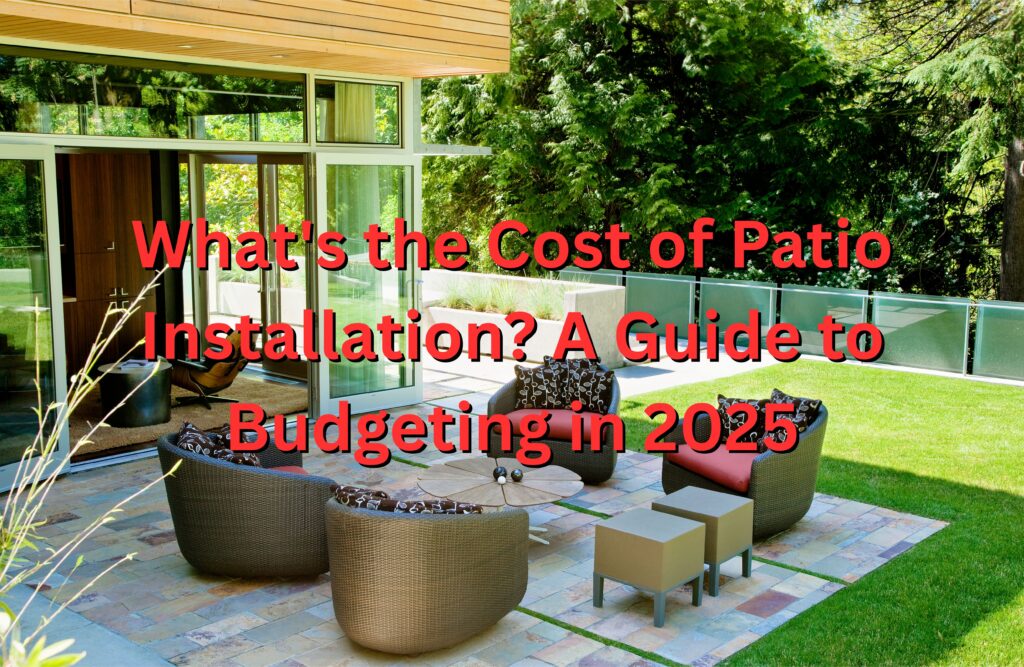Table of Contents
Adding a patio is one of the most valuable home upgrades you can make in 2025. Not only does it provide extra living space outdoors, but it also increases curb appeal and property value. From backyard barbecues to relaxing evenings around a fire pit, a patio creates a versatile gathering spot. But before you dive into design ideas, it’s important to understand the financial side. Patio installation costs vary widely based on material, size, labor, and optional upgrades. In this guide, we’ll break down average prices, explain hidden expenses, and provide practical budgeting tips so you can plan your project with confidence.
Average Cost of Patio Installation in 2025
Across the United States, the average cost of patio installation in 2025 ranges between $10 and $40 per square foot. This means a basic gravel patio might cost just over a thousand dollars, while a premium natural stone design could run well over $10,000 depending on size and features. For a standard 12×12 patio (144 square feet), most homeowners spend $1,500 to $5,500, but larger or more complex builds can easily exceed $8,000.
Several factors influence the total price. Location plays a role since labor costs vary by region, with metropolitan areas typically being more expensive. Accessibility also matters—if contractors need to haul materials through narrow side yards or up slopes, labor fees will increase. Finally, the complexity of the design affects both time and cost. A simple rectangular patio is straightforward, while circular or multi-level layouts require more skill and precision.
Patio Material Costs
Material choice is the single biggest factor that determines your budget. Gravel patios are the most affordable, requiring minimal prep work and offering a casual, rustic look. They drain well but require occasional raking and replenishing. Concrete patios provide a durable, low-maintenance surface at a moderate cost. They can be plain slabs or upgraded with decorative finishes like stamping, staining, or scoring, which adds to the price but also to the visual appeal.
Paver patios—made of brick, concrete, or stone—offer a classic and highly customizable look. They come in a variety of shapes and colors, allowing for unique patterns. While pavers cost more upfront, they are easy to repair since individual units can be replaced if damaged. Natural stone patios are at the top end of the price scale. Materials like bluestone, flagstone, and slate create a timeless and elegant look, but quarrying, shipping, and installation push up costs significantly.
Labor and Installation Costs
Labor typically makes up 40–60% of the total budget. In 2025, professional installation ranges from $4 to $20 per square foot, depending on the material and difficulty of the job. Concrete slabs and gravel patios are generally faster to install, which keeps labor costs low. Paver patios require more precision because each unit must be placed and leveled, while natural stone often involves hand-fitting irregular shapes, increasing labor hours.
For homeowners who enjoy DIY, installing a patio themselves may seem like an attractive way to save money. While DIY can reduce labor costs, it’s important to factor in equipment rentals, material delivery, and the potential for costly mistakes. Poor grading, improper base preparation, or uneven paver installation can cause long-term issues like drainage problems or cracking. Many homeowners find that paying professionals upfront saves money and stress in the long run.
If this is your first patio project, our detailed guide on First-Time Patio Installation walks you through the planning, base preparation, paver laying, and finishing steps to ensure a smooth and successful build.
Additional Expenses to Consider
Beyond the base cost of materials and labor, several additional expenses can impact your total budget. Site preparation is one of the most overlooked costs. Removing sod, demolishing an old patio, or leveling a sloped yard can add anywhere from $500 to $2,000. If your property requires significant grading or drainage improvements, the price may be higher.
Permits are another consideration. While not required everywhere, some municipalities mandate permits for patios, especially if they are elevated or attached to the home. Permit fees usually range from $50 to $500. Maintenance costs also vary by material. For example, concrete and gravel patios need little upkeep, while pavers and stone patios often require sealing every 1–2 years, costing $150–$400 per visit.
Upgrades can dramatically change the final cost of your patio. Adding a fire pit may add $500 to $2,500, while features like seating walls, outdoor kitchens, or custom lighting can add several thousand dollars. While these features increase the price, they also elevate the functionality and enjoyment of your outdoor space.
Patio Installation Cost Table
| Material / Aspect | Cost per Sq. Ft. (Angi) | Cost per Sq. Ft. (Steve’s Services) |
|---|---|---|
| Gravel | $1 – $4 | $2.35 – $6.20 |
| Concrete (basic slab) | $3 – $8 | $4 – $16 |
| Concrete (decorative) | $6 – $15 | - |
| Brick Pavers | $8 – $25 | $14 – $24 |
| Natural Stone / Flagstone | $3 – $35 | $15 – $31 |
| Permeable Pavers | $10 – $30 | - |
| Labor (installation) | $5 – $20 | $4 – $18 |
| 12×12 Patio (144 sq. ft.) | $1,500 – $5,500 avg. | $1,220 – $9,760 |
Budgeting Tips for 2025
Budgeting for a patio starts with setting clear priorities. Decide whether you want a simple, functional space or a statement feature with premium materials and custom details. Once you know your goals, request multiple quotes from local contractors to compare pricing. Be sure each quote includes materials, labor, permits, and site preparation so you can make an apples-to-apples comparison.
Always add a 10–15% contingency fund to your budget for unexpected costs. These may include hidden soil problems, delivery delays, or changes in material availability. Another smart strategy is to think long-term. Spending more upfront on durable materials and professional installation may reduce maintenance costs and extend the life of your patio, saving money in the future.
Conclusion
Installing a patio in 2025 can cost as little as a few thousand dollars or exceed ten thousand depending on material choice, size, and added features. Gravel offers an affordable entry point, concrete balances durability with cost, pavers allow for customization, and natural stone delivers unmatched elegance. With professional installation, thoughtful upgrades, and proper budgeting, you can create a beautiful outdoor retreat that adds both lifestyle value and curb appeal. By planning ahead and understanding all the cost factors, your patio investment will pay off in both enjoyment and long-term home value. For more detailed information and tailored advice, visit our page on patio installation. For support on your next patio installation project, please feel free to reach out through our contact form, and our team will be happy to help.



